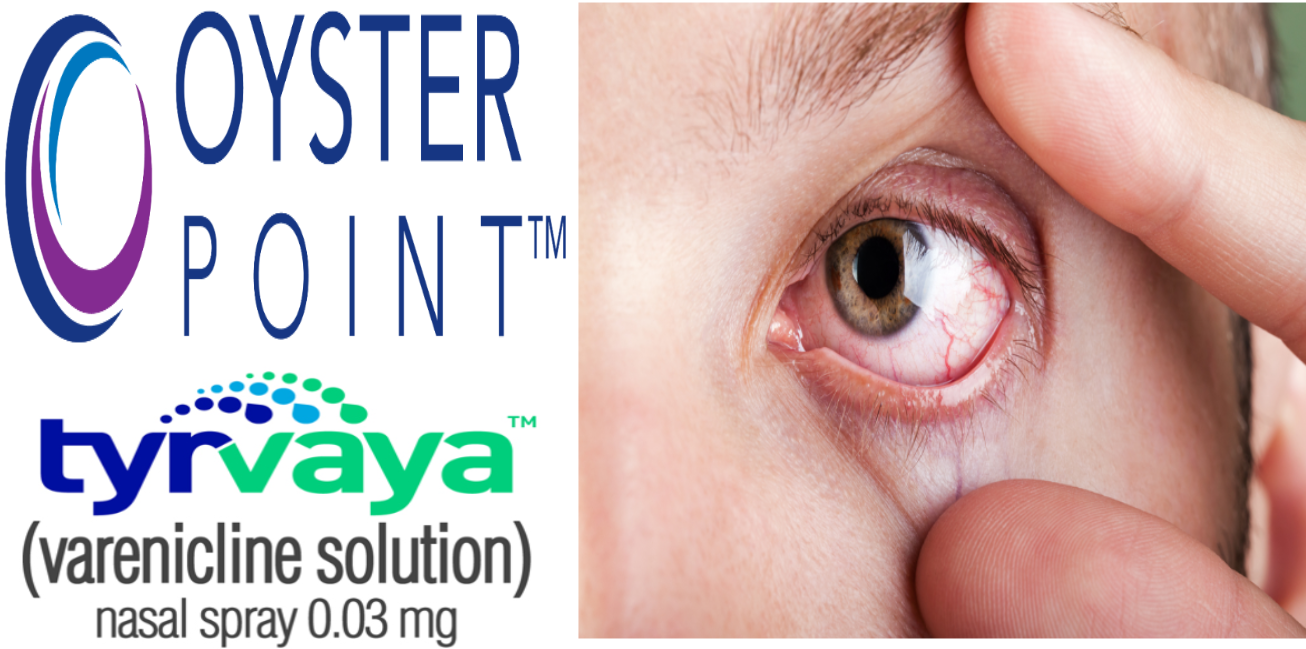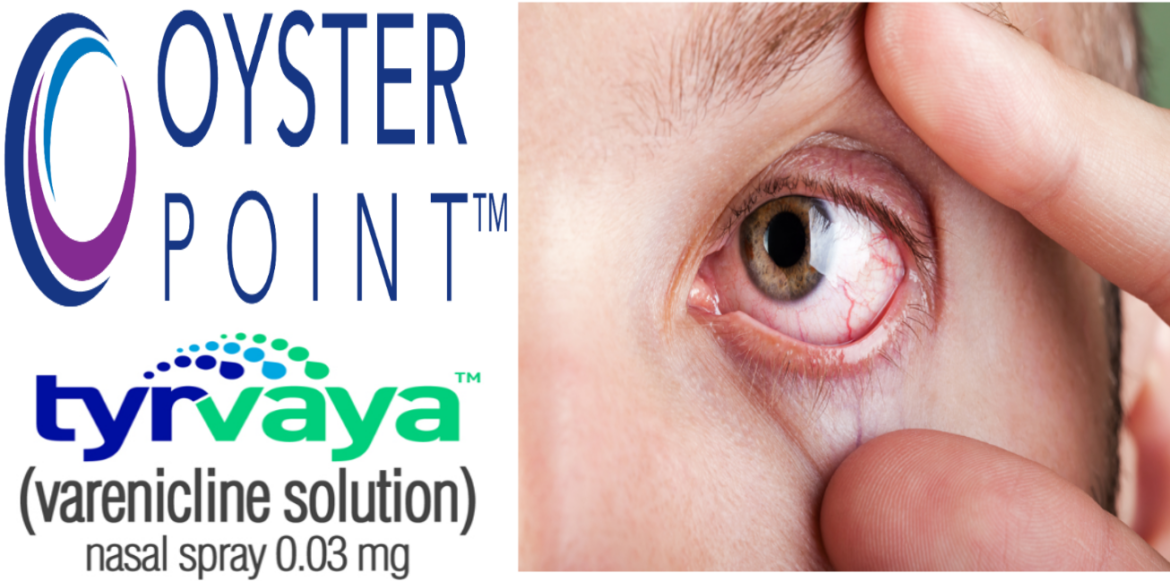- The TYRVAYA nasal spray is the first approved nasal spray to treat dry eye disease.
- TYRVAYA nasal spray will benefit the patients who struggle to administer topical eye drops independently
- Varenicline binds to the trigeminal nerve when administered in the nasal cavity this binding triggers the parasympathetic nervous system, initiating the production of all three layers of the tear film.
- TYRVAYA was studied in a broad patient population of adults with mild, moderate, or severe dry eye disease.
- This is the first treatment for dry eyes that comes as a nasal spray.
- TYRVAYA will be available with a prescription in November 2021.
- Dry eye disease is a chronic condition that impacts an estimated 38 million people in the U.S.
- Oyster Point Pharma is a commercial-stage biopharmaceutical company focused on the discovery, development, and commercialization of first-in-class pharmaceutical therapies to treat ophthalmic diseases.

TYRVAYA (Varenicline Solution) Oyster Point’s Drug becomes First FDA-approved Nasal Spray to Treat Dry Eyes.
Oyster Point Pharma, Inc. announced that the US Food and Drug Administration (FDA) has approved Tyrvaya (varenicline solution) nasal spray 0.03 mg for the treatment of the signs and symptoms of dry eye disease.
The drug is the first nasal spray approved for treating dry eye and it’s also the first approved product for Oyster Point. The Princeton, New Jersey-based biotech will market the spray under the name “Tyrvaya.” Oyster Point said it expects will become available in November coming in cartons containing two multidose nasal spray bottles. Each bottle will have enough doses for 15 days.
The Oyster Point drug offers a new way to treat dry eye disease, a condition whose growing prevalence the company attributes to an aging population, autoimmune conditions, contact lens wear, and time spent viewing digital screens. The drug is designed to stimulate the nicotinic acetylcholine receptor. In the Pfizer smoking cessation product Chantix, the pill’s active ingredient, Varenicline, binds to these receptors and stimulates them, but not to the degree that nicotine does. Binding to the receptors also prevents nicotine from activating them. Oyster Point’s nasal spray targets the same receptors, but with the intended effect of activating them to stimulate the cells and glands governing tear film production.
Tyrvaya is meant to be sprayed into each nostril twice-daily. Oyster Point said that as a nasal spray, its drug offers a new way to treat dry eye without administering medication to an already irritated eye surface. Also, for patients who have trouble giving themselves eye drops, the nasal spray formulation could be an easier alternative.
The FDA based its approval on the results of three clinical trials enrolling more than 1,000 patients with mild, moderate, or severe dry eye disease. Patients were permitted to use artificial tears during the study. The drug was evaluated by measuring the change in score according to a scale that rates the level of eye dryness discomfort. Results showed that patients treated with the Oyster Point drug showed statistically significant improvement in tear film production at week four of the study. The results also showed improvement in basal tear secretion in the treatment groups compared to those who were given a nasal spray with no active ingredient.
The most common adverse reaction in the studies was sneezing, reported in 82% of patients. Other events reported in the clinical trials included cough, throat irritation, and nose irritation.
An eye dryness score, achieved by having patients rate their level of eye dryness discomfort, was evaluated in both clinical settings and in a Controlled Adverse Environment, a chamber that offers a controlled setting for evaluating dry eye drugs. The Oyster Point drug met the eye dryness score goal in clinical settings. But the pandemic threw a wrench into plans to evaluate the drug in the controlled environment. The company said in its annual report under pandemic conditions some patients were unable to visit sites or sites were not comfortable putting staff into the controlled environment. Those factors led to results in the controlled setting that were not statistically significant.
Oyster Point will need to do some negotiating to receive all of the financing it planned to commercialize its new drug. In August, the company secured $125 million in debt financing from OrbiMed Royalty & Credit Opportunities. The agreement provides for loans in three separate tranches: $45 million up front; $50 million upon FDA approval of the drug; and another $30 million upon meeting a recurring sales threshold.
In a securities filing, Oyster Point said that the second tranche is contingent on a label that includes eye dryness score data from clinical trials. Because the controlled environment results fell short of statistical significance, the approved label does not include those data. Unless OrbiMed waives the eye dryness score requirement, Oyster Point will be unable to secure the second tranche, and therefore won’t be eligible for the third tranche. But the company does have cash available. According to the filing, Oyster Point’s cash holdings totaled $184 million as of Sept. 30.
Clinical trial studies
Tyrvaya nasal spray was studied in the ONSET-1, ONSET-2, and MYSTIC clinical trials in over 1,000 patients with mild, moderate or severe dry eye disease. In ONSET-1 and ONSET-2, the majority of patients were female (74%), the mean (standard deviation [SD]) age was 61 (12.5) years, the mean (SD) baseline anesthetized Schirmer’s score was 5.1 mm (2.9), and the mean (SD) baseline eye dryness score (EDS) was 59.3 (21.6). Use of artificial tears was allowed during the studies. Enrollment criteria included minimal signs [i.e., anesthetized Schirmer’s score (range, 0-10 mm) and corneal fluorescein staining (range, 2-14)] and enrollment was not limited by baseline EDS (range, 2-100).
Basal tear production was measured by change from baseline in anesthetized Schirmer’s score, based on a test that utilizes calibrated filter paper to wick tears and measure tear volume. Eye dryness was measured by change from baseline in Eye Dryness Score, a visual analogue scale where patients rated their level of eye dryness discomfort, with a greater reduction in score indicating greater symptom relief. Eye dryness score was evaluated both in the Controlled Adverse Environment (CAE) and in the clinic environment.
Tyrvaya-treated patients showed statistically significant improvements in tear film production as assessed using the anesthetized Schirmer’s score (0-35 mm) at Week 4. Of the patients treated with Tyrvaya, 52% achieved =10 mm increase in Schirmer’s score from baseline in the ONSET-1 study, and 47% achieved =10 mm increase in Schirmer’s score from baseline in the ONSET-2 study, compared to 14% and 28% of vehicle-treated patients in the ONSET-1 study and the ONSET-2 study, respectively at Week 4 (p<0.01 in both studies). Of the patients treated with Tyrvaya, the mean change in Schirmer’s score was 11.7 mm and 11.3 mm as compared to 3.2 mm and 6.3 mm in the vehicle treated patients in the ONSET-1 study and ONSET-2 study, respectively at Week 4.
In the Controlled Adverse Environment (CAE), in ONSET-1 the observed mean change from baseline in Eye Dryness Score at week 3 was -16.0 mm in Tyrvaya-treated patients (n=45) compared to -4.4 mm in vehicle- treated patients (n=42). This endpoint was met (p<0.01). In ONSET-2, the observed mean change from baseline in Eye Dryness Score at week 4 was -10.3 mm in Tyrvaya-treated patients (n=187) compared to -7.4 mm in vehicle-treated patients (n=169). This endpoint was not met (p>0.05).
In the clinic environment, in ONSET-1 the mean change from baseline in eye dryness score at week 4 was -18.9 mm in Tyrvaya-treated patients (n=46) compared to -5.4 mm in vehicle-treated patients (n=43). This endpoint was met (p=0.01). In ONSET-2, the mean change from baseline in eye dryness score at week 4 was -19.8 mm in Tyrvaya-treated patients (n=255) compared to -15.4 mm in vehicle-treated patients (n=248). As the CAE endpoint was not statistically significant, this secondary endpoint was not eligible for statistical testing and was not met.
Oyster Point’s Commitment to Patient Access
Oyster Point is committed to supporting the dry eye disease community by supporting access to medication for appropriate patients. The company has launched a patient support program called TEAMTyrvayaä
About Dry Eye Disease and the Role of Tear Film
Dry eye disease is a chronic condition that impacts an estimated 38 million people in the U.S. and is growing in prevalence1,2. It can cause persistent stinging, scratching, burning sensations, sensitivity to light, blurred vision, and eye fatigue. Dry eye disease is a multifactorial disease of the ocular surface characterized by disruption of the tear film. Human tear film is a complex mixture of more than 1,500 different proteins, including growth factors and antibodies, as well as numerous classes of lipids and mucins3. Natural tear film protects and lubricates the eyes, washes away foreign particles, contains growth factors and antimicrobial components, and creates a smooth surface that forms the primary refractive surface of the eye.
About TYRVAYA (Varenicline solution) Nasal Spray
TYRVAYA (varenicline solution) Nasal Spray 0.03 mg (formerly referred to as OC-01) is a highly selective cholinergic agonist that is FDA-approved to treat the signs and symptoms of dry eye disease as a multidose nasal spray. The parasympathetic nervous system, the “rest and digest” system of the body, controls tear film homeostasis partially via the trigeminal nerve, which is accessible within the nose. The efficacy of TYRVAYA Nasal Spray in dry eye disease is believed to be the result of varenicline’s activity at heteromeric sub-type(s) of the nicotinic acetylcholine (nACh) receptor where its binding produces agonist activity and activates the trigeminal parasympathetic pathway resulting in increased production of basal tear film as a treatment for dry eye disease. Varenicline binds with high affinity and selectivity at human α4β2, α4α6β2, α3β4, α3α5β4 and α7 neuronal nicotinic acetylcholine receptors. The exact mechanism of action is unknown at this time.
TYRVAYA Important Safety Information
The most common adverse reaction reported in 82% of patients was sneezing. Events that were reported in 5- 16% of patients were cough, throat irritation, and instillation-site (nose) irritation. There are no contraindications associated with TYRVAYAÔ (varenicline solution) Nasal Spray.
About Oyster Point Pharma, Inc.
Oyster Point Pharma is a commercial-stage biopharmaceutical company focused on the discovery, development and commercialization of first-in-class pharmaceutical therapies to treat ophthalmic diseases. In October 2021, Oyster Point Pharma received FDA-approval for TYRVAYAÔ (varenicline solution) Nasal Spray for the treatment of the signs and symptoms of dry eye disease. Oyster Point has a growing pipeline of clinical and pre-clinical programs and continues to expand its research and development pipeline through internal innovation and external collaborations. Oyster Point is continuously striving to advance breakthrough science and deliver therapies seeking to address the unmet needs of patients with ophthalmic disease and the eye care professionals who take care of them.


